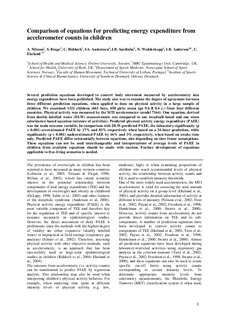| dc.contributor.author | Nilsson, Andreas | |
| dc.contributor.author | Brage, Søren | |
| dc.contributor.author | Riddoch, Chris J. | |
| dc.contributor.author | Anderssen, Sigmund A. | |
| dc.contributor.author | Sardinha, Luis B. | |
| dc.contributor.author | Wedderkopp, Niels | |
| dc.contributor.author | Andersen, Lars Bo | |
| dc.contributor.author | Ekelund, Ulf | |
| dc.date.accessioned | 2009-11-16T11:49:11Z | |
| dc.date.issued | 2008-01-14 | |
| dc.identifier | Seksjon for idrettsmedisinske fag / Department of Sports Medicine | |
| dc.identifier.citation | Scandinavian Journal of Medicine & Science in Sports. 2008, 18(3), 643-650 | en |
| dc.identifier.issn | 0905-7188 | |
| dc.identifier.uri | http://hdl.handle.net/11250/170499 | |
| dc.description | I Brage finner du siste tekst-versjon av artikkelen, og den kan inneholde ubetydelige forskjeller fra forlagets pdf-versjon. Forlagets pdf-versjon finner du på www.wiley.com: http://www3.interscience.wiley.com/journal/120174186/abstract / In Brage you'll find the final text version of the article, and it may contain insignificant differences from the journal's pdf version. The definitive version is available at www.wiley.com: http://www3.interscience.wiley.com/journal/120174186/abstract | en |
| dc.description.abstract | Several prediction equations developed to convert body movement measured by accelerometry into energy expenditure have been published. The aim of this study was to examine the degree of agreement between three different prediction equations, when applied to data on physical activity in a large sample of children. We examined 1321 children (663 boys, 658 girls; mean age 9.6 +/- 0.4 years) from four different countries. Physical activity was measured by the MTI accelerometer. One equation, derived from doubly labeled water (DLW) measurements, was compared with one treadmill-based (TM) and one room calorimeter-based (CAL) equation (mixture of activities). Predicted physical activity energy expenditure (PAEE) was the main outcome variable. In comparison with DLW-predicted PAEE, both laboratory-derived equations significantly (P < 0.001) overestimated PAEE by 17% and 83%, respectively, when based on a 24-h prediction, while the TM equation significantly (P < 0.001) underestimated PAEE by 46%, when based on awake time only. In contrast, the CAL equation agreed better with the DLW equation under the awake time assumption. Predicted PAEE differ substantially between equations, depending on time-frame assumptions, and interpretations of average levels of PAEE in children from available equations should be made with caution. Further development of equations applicable to free-living scenarios is needed. | en |
| dc.format.extent | 144886 bytes | |
| dc.format.mimetype | application/pdf | |
| dc.language.iso | eng | en |
| dc.publisher | Wiley InterScience | en |
| dc.subject | physical activity | en |
| dc.subject | activity monitors | en |
| dc.subject | calibration | en |
| dc.subject | energy cost | en |
| dc.title | Comparison of equations for predicting energy expenditure from accelerometer counts in children | en |
| dc.type | Peer reviewed | en |
| dc.type | Journal article | en |
| dc.subject.nsi | VDP::Social science: 200::Social science in sports: 330::Other subjects within physical education: 339 | en |
| dc.source.pagenumber | 643-650 | en |
| dc.source.volume | 18 | en |
| dc.source.journal | Scandinavian Journal of Medicine & Science in Sports | en |
| dc.source.issue | 3 | en |
